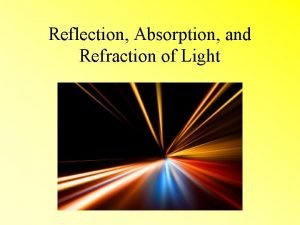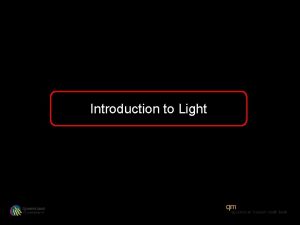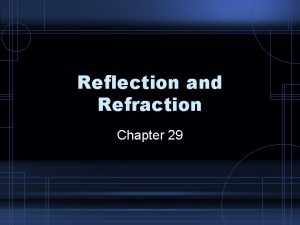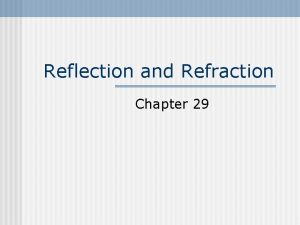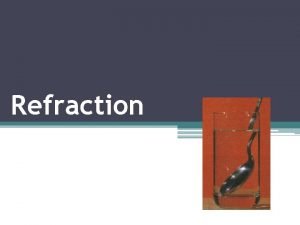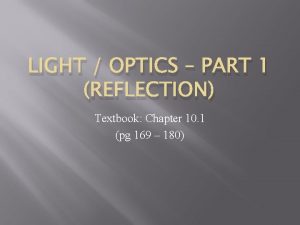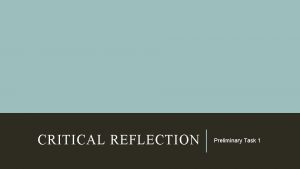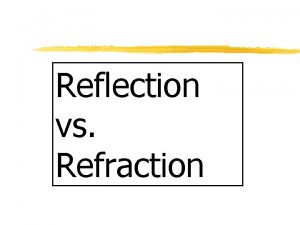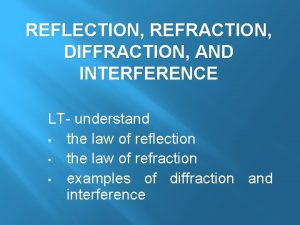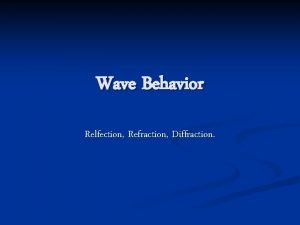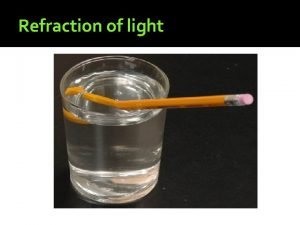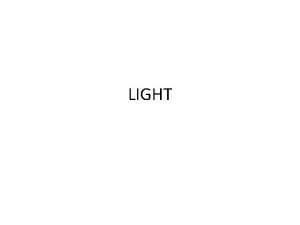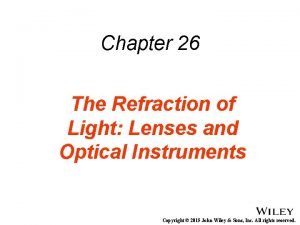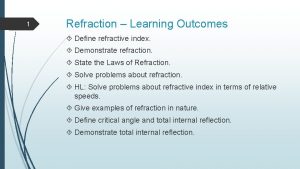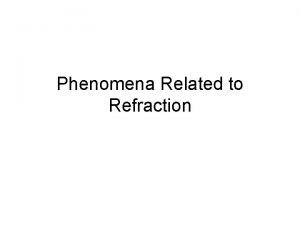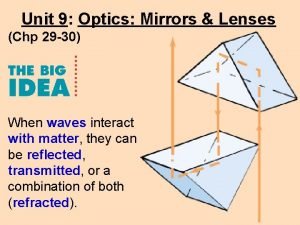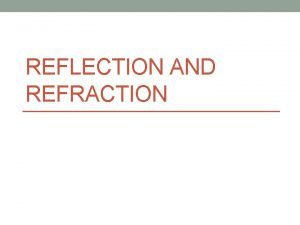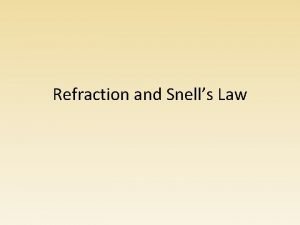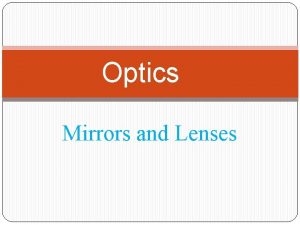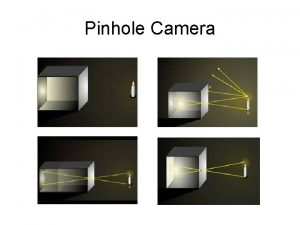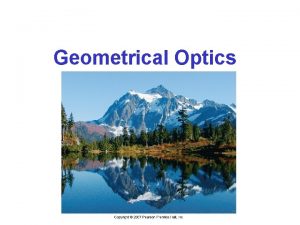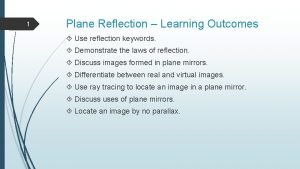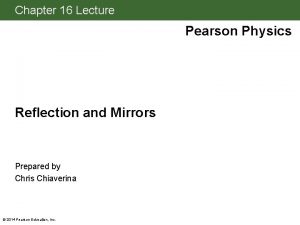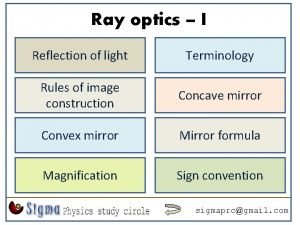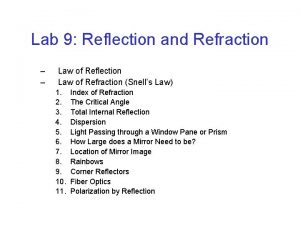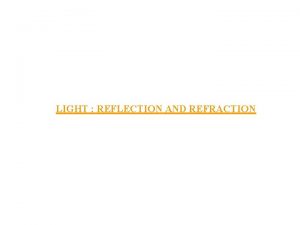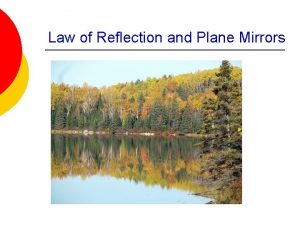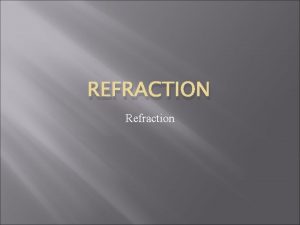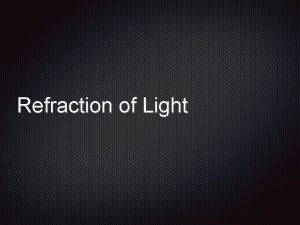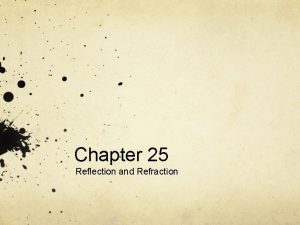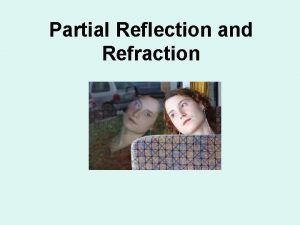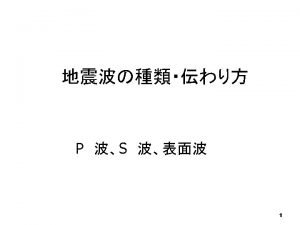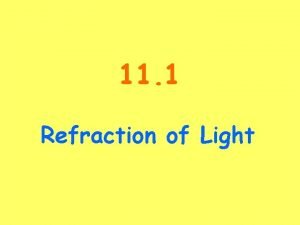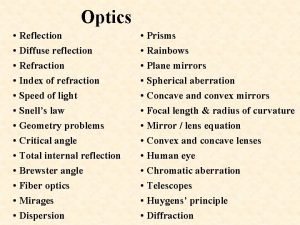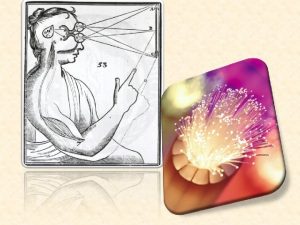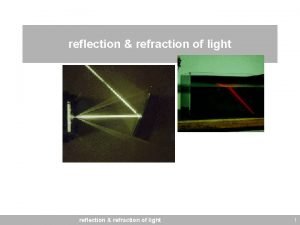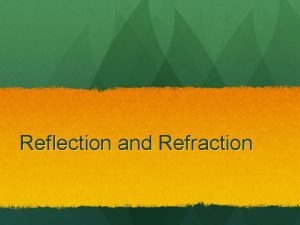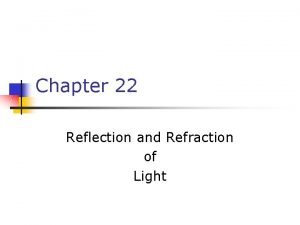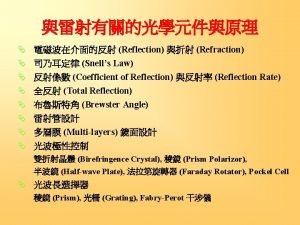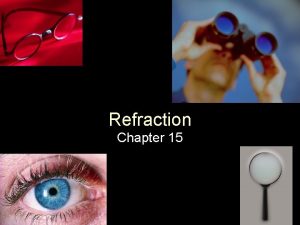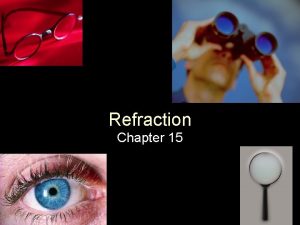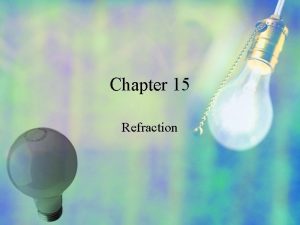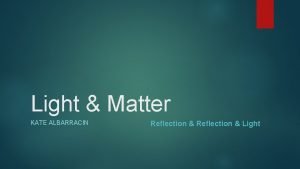Chapter 23 Reflection and Refraction of Light Copyright















































- Slides: 47

Chapter 23: Reflection and Refraction of Light Copyright © The Mc. Graw-Hill Companies, Inc. Permission required for reproduction or display.

Figure 23. 02 Nature of Light: Waves vs Particles Early beliefs: Light is a stream of particles emitted either by the object being viewed or emanating from the eyes of the viewer. q Newton was the chief architect of the particle theory of light: He believed the particles left the object and stimulated the sense of sight upon entering the eyes. q Christian Huygens argued that light might be some sort of a wave motion. q Thomas Young (1801) provided the first clear demonstration of the wave nature of light: Because of their interference properties. q Einstein (in 1905) proposed an explanation of the photoelectric effect that used the idea of quantization. The quantization model assumes that the energy of a light wave is present in particles called photons.

Figure 23. 02 Wavefronts and Rays, 1

Figure 23. 03 Wavefronts and Rays, 2

Figure 23. 04 Wavefronts and Rays, Huygen’s Principle • Huygens assumed that light is a form of wave motion rather than a stream of particles • Huygens’s Principle is a geometric construction for determining the position of a new wave at some point based on the knowledge of the wave front that preceded it

Figure 23. 05 Constuction of Plane Waves: Example 23. 1

Figure 23. 06 Reflection of Light: Specular and Diffuse Reflection

Figure 23. 08 The Laws of Reflection • The normal is a line perpendicular to the surface – It is at the point where the incident ray strikes the surface • The incident ray makes an angle of θi with the normal • The reflected ray makes an angle of θr with the normal Laws of Reflection • The angle of reflection is equal to the angle of incidence θi = θr • The incident ray, the reflected ray and the normal are all in the same plane

Figure 23. 09 The Refraction of Light: Snell’s Law • Light may refract into a material where its speed is lower • The angle of refraction is less than the angle of incidence – The ray bends toward the normal

Snell’s Law – Example • Light is refracted into a crown glass slab • θ 1 = 30. 0 o, θ 2 = ? • n 1 = 1. 00 and n 2 = 1. 52 – From Table 23. 1 (page 844) • θ 2 = sin-1(n 1 / n 2) sin θ 1 = 19. 2 o • The ray bends toward the normal, as expected

Figure 23. 12 Physics at Home

Figure 23. 13 Mirages

Figure 23. 13 b Mirages

Figure 23. 14 Mirages

Figure 23. 15 Dispersion in a Prism • For a given material, the index of refraction varies with the wavelength of the light passing through the material • This dependence of n on λ is called dispersion • Snell’s law indicates light of different wavelengths is bent at different angles when incident on a refracting material

Figure 23. 16 ab Total Internal Reflection

Figure 23. 16 cd Total Internal Reflection

Double Rainbow • The secondary rainbow is fainter than the primary • The secondary rainbow arises from light that makes two reflections from the interior surface before exiting the raindrop • Higher-order rainbows are possible, but their intensity is low

Figure 23. 17 Partial and Total Internal Reflection • There is a particular angle of incidence that will result in an angle of refraction of 90° – This angle of incidence is called the critical angle, θC

Fiber Optics • • • An application of internal reflection Plastic or glass rods are used to “pipe” light from one place to another Applications include: – medical use of fiber optic cables for diagnosis and correction of medical problems – Telecommunications

Figure 23. 24 Polarization by Reflection: Brewster’s Angle A 2 -component unpolarized Light: At some angle, the reflected and refracted rays would be perpendicular to each other => q. B + qt = 90 o The reflected beam is fully polarized: one component only.

Figure 23. 25 Formation of Images Through Reflection or Refraction

Notation for Mirrors and Lenses • The object distance is the distance from the object to the mirror or lens: – Denoted by p • The image distance is the distance from the image to the mirror or lens: – Denoted by q – Images are formed at the point where rays actually intersect or appear to originate • The lateral magnification of the mirror or lens is the ratio of the image height to the object height: – Denoted by M • A real image is one in which light actually passes through the image point: Real images can be displayed on screens • A virtual image is one in which the light does not pass through the image point – Virtual images cannot be displayed on screens – The light appears to diverge from that point • To find where an image is formed, it is always necessary to follow at least two rays of light as they reflect from the mirror

Figure 23. 26 Example 23. 4

Figure 23. 27 Plane Mirrors

Figure 23. 30 Convex Spherical Mirrors The focal point of a convex mirror is on the principal axis a distance R/2 behind the mirror

Figure 23. 31 Convex Spherical Mirrors: How do they work?

Figure 23. 32 Convex Spherical Mirrors: How do they work?

Figure 23. 34 Concave Spherical Mirrors

Figure 23. 35 Concave Spherical Mirrors: How do they work?

Figure 23. 36

Figure 23. 38 Transverse Magnification

Figure 23. 39 The Mirror Equation

Figure 23. 40 Objects Located at Infinity or at Large Distances

Table 23. 02 Sign Conventions

Figure 23. 42 Thin Lenses

Figure 23. 44 Focal Points and Principal Rays

Figure 23. 46 Shapes of Some Diverging & Converging Lenses

Figure 23. 47 a Forming Real Images

Figure 23. 47 b Forming Virtual Images

Figure 23. 49 The Magnification & Thin Lens Equation

Table 23. 04 Sign Conventions for Mirrors and Lenses

Lens and Mirror Aberrations • One of the basic problems is the imperfect quality of the images – Largely the result of defects in shape and form • Two common types of aberrations exist – Spherical aberration – Chromatic aberration

Spherical Aberration • Results from the focal points of light rays far from the principle axis are different from the focal points of rays passing near the axis • For a mirror, parabolic shapes can be used to correct for spherical aberration

Chromatic Aberration • Different wavelengths of light refracted by a lens focus at different points – Violet rays are refracted more than red rays – The focal length for red light is greater than the focal length for violet light • Chromatic aberration can be minimized by the use of a combination of converging and diverging lenses

Homework Assignment Due Wednesday 8/1/2007 23. 1, 23. 2, 23. 3, 23. 4, 23. 6, 23. 7, 23. 8, 23. 9 Explain your answers Try the conceptual and multiple choice questions

Figure 23. 49 End of Chapter 23
 Reflection refraction transmission and absorption of light
Reflection refraction transmission and absorption of light Why can we represent light rays using a ruler
Why can we represent light rays using a ruler Rainbow total internal reflection
Rainbow total internal reflection Chapter 29 reflection and refraction
Chapter 29 reflection and refraction Light light light chapter 23
Light light light chapter 23 Light light light chapter 22
Light light light chapter 22 Chapter 22
Chapter 22 What is the reaction of the poem
What is the reaction of the poem Refraction examples
Refraction examples Bill nye light and optics
Bill nye light and optics What is invictus
What is invictus Bill nye reflection and refraction
Bill nye reflection and refraction Venn diagram of geometric optics and physical optics
Venn diagram of geometric optics and physical optics Series and parallel circuits similarities
Series and parallel circuits similarities Lighthe
Lighthe Reflection and refraction learning task 1
Reflection and refraction learning task 1 Reflection vs refraction
Reflection vs refraction Reflection refraction diffraction interference
Reflection refraction diffraction interference Reflection refraction diffraction
Reflection refraction diffraction When a wave strikes an object and bounces off
When a wave strikes an object and bounces off Reflection refraction
Reflection refraction Cause of refraction of light
Cause of refraction of light Concave vs convex light refraction
Concave vs convex light refraction Refraction of light in lenses
Refraction of light in lenses Laws of refraction
Laws of refraction Phenomena related to refraction
Phenomena related to refraction The action of lenses depends mainly on
The action of lenses depends mainly on When a wave reaches a boundary it
When a wave reaches a boundary it Refraction of light
Refraction of light Mirage illusion
Mirage illusion Noise and light discipline
Noise and light discipline Plano convex lens
Plano convex lens Ye are the salt of the earth
Ye are the salt of the earth Reflection at plane surfaces
Reflection at plane surfaces Reflection light analogy
Reflection light analogy Light strikes
Light strikes Mirror formula
Mirror formula Plane mirror used
Plane mirror used Reflection of light
Reflection of light Reflection of light example
Reflection of light example Gmail
Gmail Lab 9
Lab 9 Refraction through a rectangular glass slab
Refraction through a rectangular glass slab Characteristics of light
Characteristics of light Law of reflection of light
Law of reflection of light Put out the light othello
Put out the light othello Leucoplast double membrane
Leucoplast double membrane Or the bending of light and the bouncing off of light
Or the bending of light and the bouncing off of light
